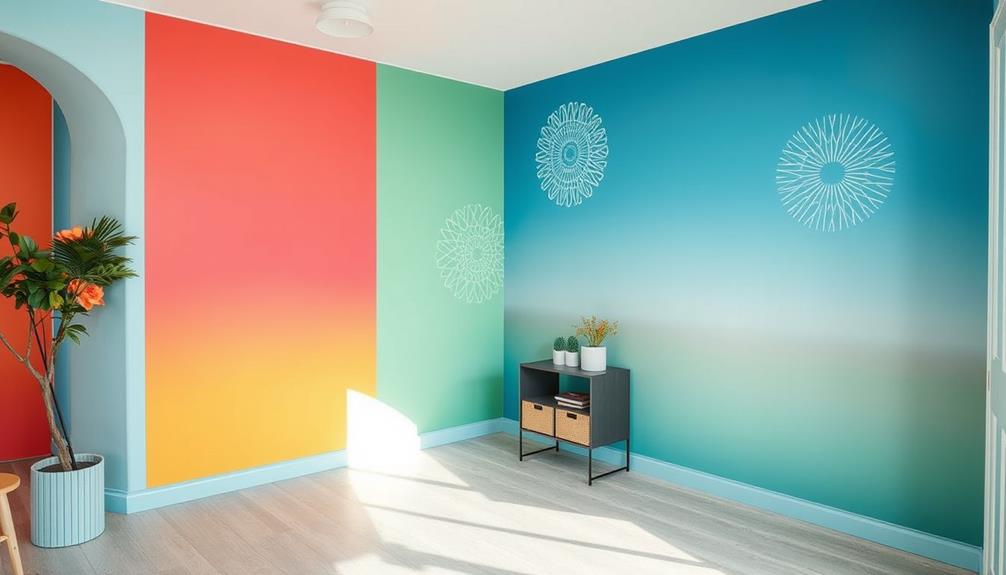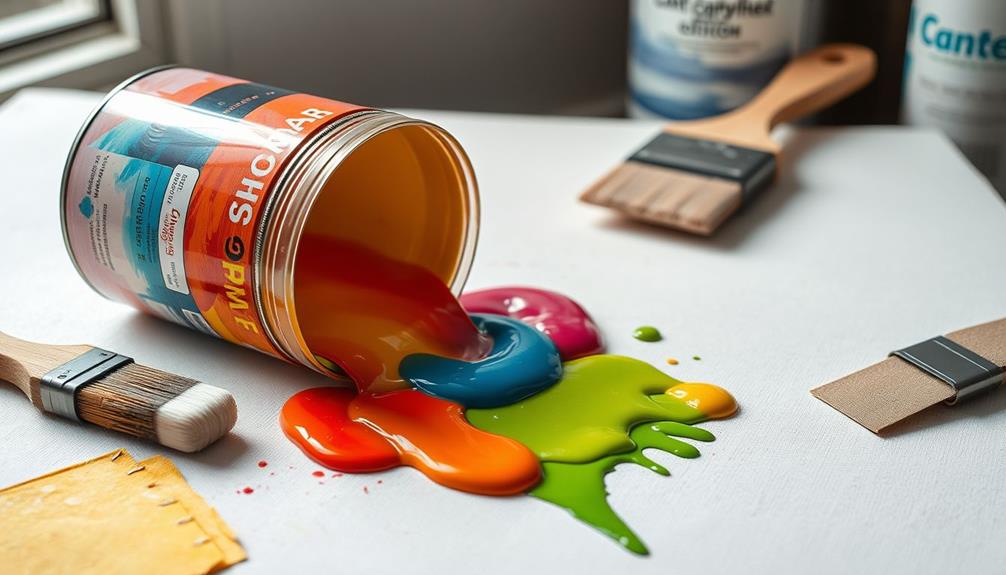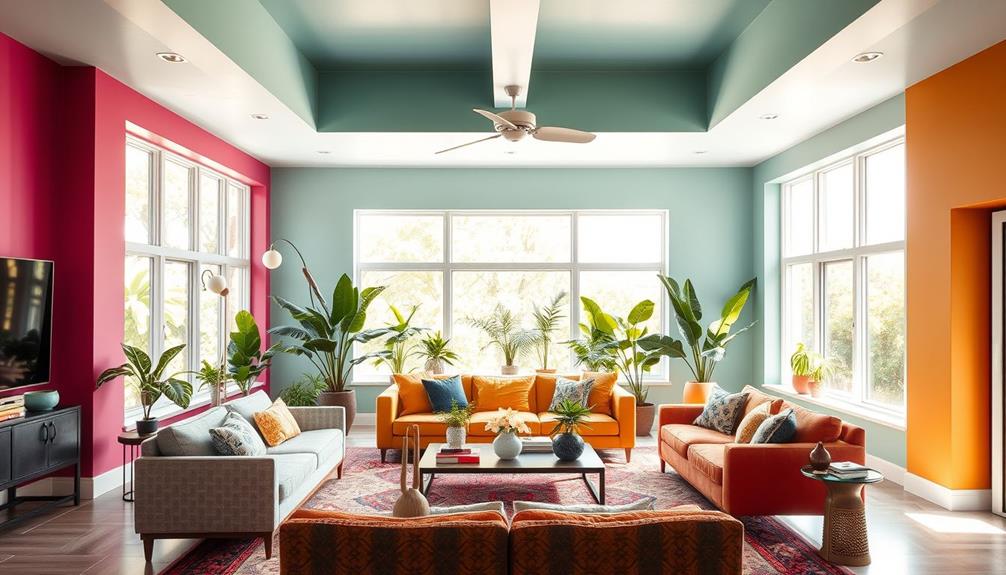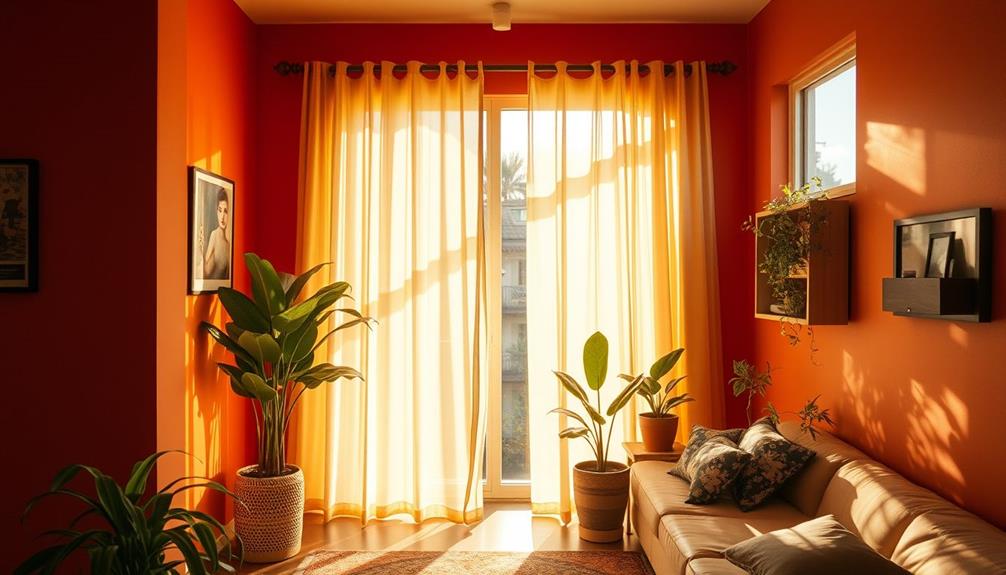Color’s ability to completely change the ambiance of a room is truly impactful. You have the power to alter the mood and energy of a space through the simple act of selecting the right colors. Warm colors can bring vibrancy and joy, making them ideal for social areas, while cool tones can create peaceful retreats in your bedroom. To create the illusion of a larger space, consider using light tones as a base and incorporating contrasting accent walls for added dimension. Remember, the quality of the paint and proper preparation are essential to ensure your changes endure. Explore how your color choices can elevate the atmosphere of your home and uncover the techniques that will enhance every room.
Key Takeaways
- Colors significantly influence mood; warm tones energize while cool tones promote calmness, making color choice essential for space transformation.
- The 60-30-10 rule helps achieve balanced color distribution, enhancing visual appeal and creating inviting environments.
- Quality preparation and high-quality paint ensure durability and a polished finish, preventing quick deterioration of walls.
- Harmonizing colors and textures creates a cohesive look, enhancing the overall atmosphere and inviting nature of a space.
- Lighting plays a crucial role in color perception, affecting ambiance; test samples in different lighting conditions for best results.
The Psychology of Color
When you step into a room, the colors surrounding you can instantly affect your mood and energy levels. The psychological effects of color are profound; warm hues like red and yellow can stimulate energy and spark conversation, while cool tones such as blue and green promote calmness and relaxation.
In a farmhouse bedroom design, for example, using soft blue shades can enhance feelings of tranquility and comfort. If you're looking to create a serene environment, blue shades are perfect for bedrooms and bathrooms, as they reduce stress and enhance feelings of tranquility.
In contrast, if you want to foster a lively atmosphere, especially in dining areas and kitchens, consider using warm colors like orange and yellow. These shades not only enhance appetite but also encourage social interaction, making mealtime more enjoyable.
It's important to remember that the emotional impact of color can vary across cultures—what evokes passion in one society might symbolize danger in another. By understanding these nuances, you can make informed choices in your interior design, crafting spaces that align with your desired moods and functionalities.
Ultimately, the right colors can transform your environment, influencing how you feel and interact in your home.
Techniques for Space Transformation

Transforming your space effectively requires a strategic approach to color and design. Start by choosing a neutral color as your base, which makes any room feel larger and more inviting. For smaller spaces, light colors can create the illusion of depth, while darker shades in larger areas foster a cozy atmosphere.
Additionally, consider how different color palettes can evoke specific moods, which is essential for creating the perfect ambiance for your home and exploring unique cultural experiences like those found in island getaways.
Next, consider adding an accent wall. This technique draws attention to architectural features and creates focal points, enhancing the overall perception of the room.
Don't shy away from bold colors in your furniture or decorative elements; they can considerably boost visual interest and add dynamism to your design.
Incorporate textured paint techniques, like sponging or rag rolling, to introduce dimension and character, while also helping to conceal any wall imperfections.
Following the 60-30-10 rule for color distribution—60% neutral, 30% secondary, and 10% accent—ensures a balanced design without overwhelming the space.
Importance of Quality and Preparation

Choosing the right colors and techniques sets the stage for a stunning transformation, but the significance of quality and preparation can't be overlooked. To achieve a professional-looking finish, you need to invest time and effort into proper wall preparation. This includes cleaning, repairing any imperfections, and priming the surfaces to guarantee ideal adhesion of the paint.
Additionally, utilizing tools like the Graco FFLP Fine Finish Low Pressure Reversible Tip can help reduce overspray and improve control, making intricate projects easier.
Using high-quality paint is vital, as it provides better coverage and durability, ultimately saving you time and money on touch-ups. Quality tools, like brushes and rollers, enhance your paint application, leading to a smoother, more even finish.
Remember, attention to detail is essential—skipping preparation steps can result in poor finishes that deteriorate quickly.
When painting, multiple coats may be necessary, especially with lighter colors. This highlights the need for thorough preparation and quality materials.
By taking the time to prepare your walls properly and using high-quality products, you set yourself up for success. The result? A beautifully transformed space that showcases your hard work and enhances your environment. Attention to detail is key, and incorporating unique elements such as **Indonesian textile design inspiration** can elevate the overall aesthetic. These intricate patterns and rich cultural motifs bring texture and vibrancy to your space, creating a look that’s both timeless and contemporary. The combination of thoughtful preparation and artistic influence ensures your room becomes a true reflection of your personal style.
Don't underestimate the power of quality and preparation in your painting projects!
Harmonizing Color and Texture

Creating a harmonious space involves more than just picking colors; it's about skillfully blending them with textures to elevate your design. When you harmonize colors and textures, you create a cohesive visual experience that draws people in.
Using shades of the same color provides subtlety and depth, while contrasting colors can introduce dynamic energy to a room, making your environment vibrant and engaging. To enhance your design further, consider implementing keyword clustering, as it can improve content discoverability and user experience.
Incorporating textured paint techniques, like sponging or rag rolling, adds dimension and character to your walls. These tactile elements not only enhance the aesthetic but also help conceal imperfections, enriching your space.
Thoughtful combination of colors and textures can invite interaction, making the atmosphere feel alive. To guarantee a balanced integration, apply the 60-30-10 rule for color distribution. This means using 60% neutral colors, 30% secondary colors, and 10% accent tones.
This approach prevents overwhelming the space and maintains visual interest. By focusing on harmonizing colors and textures, you'll create an inviting environment that resonates with your personal style and enhances your overall sensory experience.
Craftsmanship in Finishing Touches

When you focus on the craftsmanship in your finishing touches, the details really make a difference.
Techniques like meticulous trim work and clean lines can elevate the entire look of your space, much like how key factors in choosing a home cleaning service can greatly impact the overall cleanliness and ambiance of your home.
With the right approach, those final steps not only enhance aesthetics but also guarantee lasting quality.
Importance of Detail
Attention to detail is the cornerstone of exceptional craftsmanship in finishing touches. When you focus on meticulous trim work and clean lines, you define the quality of your paint job. These elements elevate the overall appearance, guaranteeing a professional look that speaks volumes about your effort.
Proper maintenance practices, such as guaranteeing clean surfaces and checking for imperfections, can further enhance the final outcome, especially in spaces prone to wear and tear. Additionally, adopting effective plumbing practices can prevent potential issues that may arise from water exposure in painted areas.
By investing time in proper finishing techniques, like caulking seams and conducting touch-ups, you enhance both the visual appeal and durability of your painted spaces. A well-executed finish not only makes your walls look fantastic but also contributes to their longevity, reducing the need for frequent maintenance.
The finishing touches, such as selecting the right paint sheens and colors for trim, can dramatically transform a space. This careful selection creates a cohesive look that ties everything together, giving your environment a sophisticated feel.
Incorporating attention to detail into your painting project will guarantee that every corner and edge is polished, allowing you to fully appreciate the beauty of the transformation. Ultimately, it's these finishing touches that truly make a difference, taking your project from ordinary to extraordinary.
Techniques for Polished Finishes
To achieve polished finishes, mastering specific techniques can elevate your painting project from good to exceptional. Start with meticulous trim work; paying close attention to baseboards and crown molding creates crisp, clean lines that enhance your space's aesthetic.
Additionally, using high-quality garage door openers can contribute to your home's overall appeal and security, making it a more inviting space. Before you begin painting, apply a high-quality primer. This step guarantees durable adhesion and helps prevent peeling and flaking over time.
Using painter's tape along edges is crucial for achieving a professional-looking outcome. It creates sharp boundaries between colors, guaranteeing a seamless finish once removed.
Don't overlook the importance of caulking gaps between the trim and walls; this prevents unsightly cracks and contributes to a more polished appearance.
After your initial coat, regularly inspect your work and touch up imperfections. This simple step can considerably improve both the longevity and look of your painted surfaces.
Strategic Color Use in Design

When you think about strategic color use, consider how certain shades can draw attention to key architectural features, making your space more dynamic.
For instance, using warm color schemes can create a cozy atmosphere, while soft pastels can provide a soothing environment.
By harmonizing color combinations, you can create a cohesive look that enhances the overall atmosphere.
Using color thoughtfully not only highlights focal points but also enriches the entire design aesthetic, much like how cozy teenage girl room colors can transform a space.
Color as Focal Points
How can color transform a space into a visually engaging environment? By strategically using color as focal points, you can amplify the impact of your design.
Consider using accent walls to highlight architectural features or artwork, drawing the eye and creating visual interest. Incorporating elements of nature, similar to the Cottagecore design aesthetic, can also enhance the overall ambiance.
Here are three effective strategies:
- Embrace the 60-30-10 Rule: Allocate 60% of your space to a dominant color, 30% to secondary hues, and reserve 10% for bold accent colors. This balance not only enhances aesthetics but also reinforces focal points.
- Contrast for Impact: Use contrasting colors to spotlight specific architectural details. This technique makes elements stand out, adding depth to an otherwise neutral space.
- Test Lighting Conditions: Colors can appear differently under various lighting. Always test your paint choices in different conditions to guarantee your focal points maintain their intended vibrancy throughout the day.
Harmonizing Color Combinations
Color combinations play an essential role in creating a harmonious and inviting space. By utilizing harmonizing color combinations, you can tap into the transformative power of paint, allowing your walls to breathe life into your home.
A well-thought-out color palette can create a cohesive look that enhances the emotional impact of colors throughout the room. Additionally, the choice of appliances can influence the overall ambiance, as seen with the integration of gas appliances and power outages, which can add warmth and comfort during any power situation.
To achieve balance, consider the 60-30-10 rule, where 60% is a neutral color, 30% a secondary color, and 10% an accent hue. This strategy helps distribute colors effectively while adding visual interest.
Incorporating nature-inspired hues and earthy tones can create a calming and soothing atmosphere, perfect for relaxation. Conversely, vibrant hues can stimulate energy and creativity, making them ideal for social spaces.
The Role of Lighting

Lighting plays an essential role in how we perceive color in our spaces. Whether it's the natural light streaming in through windows or the artificial lighting you choose, these factors greatly influence how paint colors appear. Here are three key points to reflect on:
- Natural light varies: North-facing rooms often have cooler light that can mute colors, while south-facing rooms bask in warm light that enhances hues.
- Artificial lighting matters: Different types of artificial lighting, like LED or fluorescent, considerably change color perception. Always reflect on the light source when selecting paint shades.
- Test your choices: Paint samples can look entirely different under various lighting conditions. Testing them helps you understand how they'll impact the room's ambiance and mood.
Keep in mind that light colors reflect more light, making small spaces feel larger, while dark colors absorb light, creating a cozy atmosphere.
The direction and intensity of light also affect not just color perception but the overall mood and atmosphere of your space. By carefully reflecting on lighting, you can truly transform your space with color.
Practical Painting Considerations

Before diving into your painting project, it's imperative to set yourself up for success with some practical considerations.
Start with proper surface preparation; clean, repair, and prime your walls to guarantee ideal paint adhesion and a long-lasting finish. Choosing high-quality paint is essential—it not only improves coverage and durability but also cuts down on the frequency of touch-ups needed over time.
Next, think about your application techniques. Whether you use brushes, rollers, or sprays, each method can greatly influence the final appearance of your project.
Don't skimp on applying multiple coats of paint, especially when shifting between contrasting colors or using lighter shades over darker surfaces. This step is critical for achieving even coverage.
Frequently Asked Questions
How Do You Transition Paint Colors Between Rooms?
To shift paint colors between rooms, choose a cohesive palette and apply the 60-30-10 rule. Test samples in natural light, use accent walls, and paint architectural features to create a seamless flow throughout your home.
How Do You Make a Room Flow With Paint Colors?
To make a room flow with paint colors, start by choosing a neutral base, then add complementary hues. Use the 60-30-10 rule for balance, ensuring colors connect visually while allowing for bold accents to shine.
What Do You Call a Paint Job That Changes Colors?
Did you know that chameleon paint can shift colors up to three different hues depending on light angles? This unique paint, often called color-shifting paint, creates stunning visual effects that captivate viewers and enhance surfaces beautifully.
What Is the Rule for Painting Walls With Different Colors?
When painting walls with different colors, use the 60-30-10 rule. This means 60% should be a neutral base, 30% a secondary color, and 10% an accent color to create balance and visual interest.
Conclusion
In the grand tapestry of your home, color acts as the brushstroke that brings life to each space. By understanding its psychology and harmonizing it with texture and light, you can transform your surroundings into a vibrant sanctuary. Just like a symphony, every hue and finish plays an essential role in creating a harmonious atmosphere. So, as you commence on this colorful journey, remember: your space is a canvas, and you hold the palette to craft your masterpiece.








